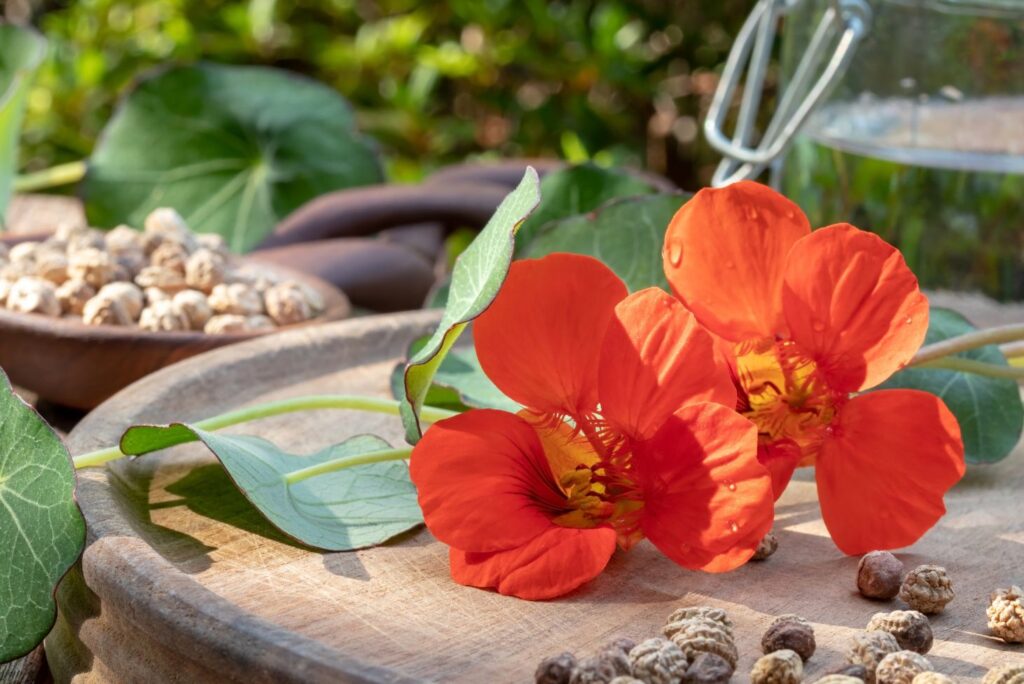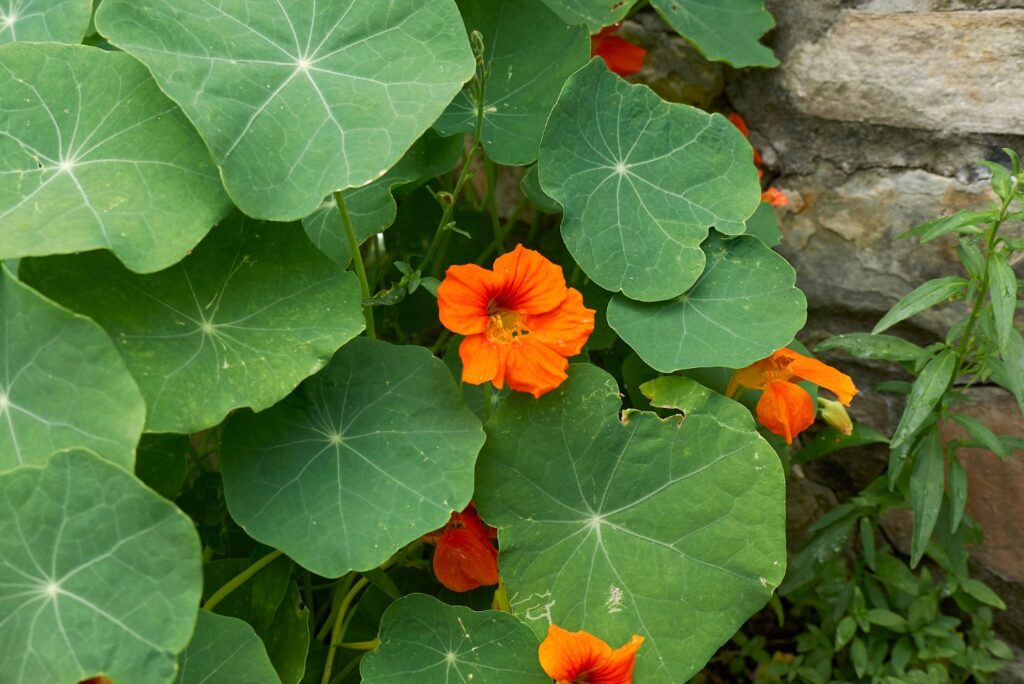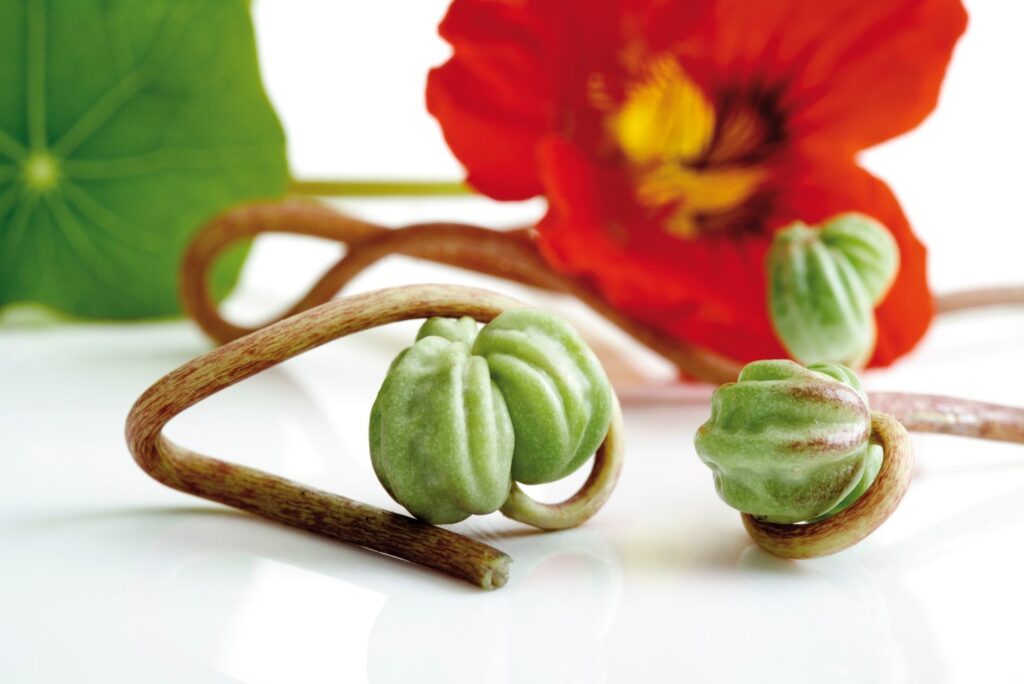Want to know what are the health uses of nasturtium, if nasturtium is edible, and how to use nasturtium for health or in cooking? Continue reading and find out.
Nasturtiums (Tropaeolum majus) are some of the most gorgeous autumn flowers that compliment any flower garden. Originally from Peru, nasturtiums have enthusiastically been adopted in most countries around the world, being used both as a decorative flowering plant, a medicinal flower and also in cooking. Yes, you heard that right. Nasturtiums are both used as a natural medicinal flower, but they are also edible and a great addition to salads or steaks. Here we are going to share with you the most important health uses of nasturtium, but also how to use nasturtium leaves, flowers, and pods to make your own natural remedies and simple ways to cook nasturtium. Let’s go.

In This Article You Will Find:
Health Uses of Nasturtium
The main health uses of nasturtium are due to its anti-inflammatory properties, which mainly protect the upper respiratory tract, oral cavity, and tonsils from pathogens. Nasturtium has powerful expectorant properties, being traditionally used for cold and flu, as well as bronchitis, asthma, or shortness of breath. Even more, studies have proven the diuretic properties of nasturtiums, and the antihypertensive effects of isoquercitrin contained in this garden flower. Thus, one of the key health uses of nasturtium is for cardio-pulmonary and heart conditions.
Nasturtiums contain thioglycosides, sulfur-containing phytochemicals with proven properties in fighting and preventing cancer. The main component of nasturtium oil is benzyl isothiocyanate, which has potent antibacterial and antifungal activity. In Europe, enteric-coated capsules of this oil are used to treat bronchial and urinary tract infections. Speaking of which, one of the most important health uses of nasturtiums relates to their candida-fighting properties. Thus, nasturtium is also used as a remedy in vaginal yeast infections as well as candidal UTIs.
Even more, studies have shown the anti-adipogenic effects of the alcoholic extract, making this garden flower an amazing remedy for obesity, but also for atherosclerosis, as you will see soon. The health uses of nasturtium don’t end here. A Brazilian study showed that nasturtium extract has anti-anxiety properties in rats, without side effects, as compared to diazepam. While an Egyptian study showed that nasturtium leaves extract ameliorating damage induced by gamma radiation in rats.
In addition, nasturtium is a known home remedy for thin, falling hair, and a tremendous natural cure for hair loss, as you will see after reading this article. Now that you know the most notable health uses of nasturtium, learn how to harvest nasturtium to make natural medicine.

How to Harvest Nasturtium for Remedies
The medicinal parts of nasturtium (Tropaeolum majus) are the leaves, flowers, and seed pods. Nasturtium flowers can be harvested during autumn, when they are in full bloom, while the nasturtium leaves can be harvested all summer and autumn season. The seed pods of nasturtium are harvested from the withered flowers, in late autumn. After cutting the leaves and flowers, layer them on a clean table to dry naturally. When they are fully dried, store the dried nasturtium leaves and flowers in separate paper bags, or glass jars. Nasturtium seed pods can also be stored in a small glass jar.
9 Natural Remedies with Nasturtium
1. Bronchitis
One of the main health uses of nasturtium is in upper respiratory tract infections, namely acute or chronic bronchitis, asthma, pneumonia and shortness of breath (emphysema). German herbal medicine recommends fresh or frozen nasturtium juice, one spoon 3 times a day. During wintertime, the nasturtium juice can be replaced with nasturtium decoction. To prepare the decoction, put a spoonful of dried herb (flowers and leaves) in one cup of boiling water and boil it on a double boiler for 20 minutes. Leave it to cool down, strain, and divide it into 3 portions. Have one portion before the meals of the day.
In addition to fresh juice or decoction, you can also use nasturtium tincture for respiratory conditions. Here is how to prepare your own nasturtium tincture at home.
Finely chop 30 grams of the young shoots of the plant with leaves and green or ripe seed pods. Put the chopped fresh plant in a glass jar and pour 200 ml of alcohol over it. Seal the jar and leave it to macerate for 14 days, in the dark. Shake the jar 2-3 times a day. Have 25 drops of the nasturtium tincture in 150 ml of water, 3 times a day, between meals. One of the main health uses of nasturtium is in alleviating chronic or acute upper respiratory inflammations.

2. Heart Conditions
Steep 20 grams of the dry plant (a blend of flowers and leaves) in one cup of hot water for 30 minutes. After straining, drink 2-3 tablespoons of infusion, 3-4 times a day, over the course of 21 days. During the summer you can have fresh cold-pressed nasturtium juice instead of the infusion. Have one tablespoon of fresh nasturtium juice 3 times a day. This natural remedy is especially used for heart conditions, including heart ischemia.
3. Lymph Glands Inflammation
One of the key health uses of nasturtium is for inflammatory processes that happen in the body. The plant is particularly used in inflammation of the lymphatic glands, constipation, respiratory and cardio-pulmonary insufficiency, and chronic bronchitis. For these conditions, there are three natural remedies with nasturtium that you can use. Let’s start with the first one.
Nasturtium Leaves Infusion
Steep 10 g of dry nasturtium leaves in a liter of hot water for 30 minutes. Cover the pot with a lid and wrap a kitchen towel around it to keep the infusion warm. Drink 100 ml of the warm infusion 3 times a day, for 3-4 weeks. Instead of the dry nasturtium leaves, you can use fresh leaves instead.
In this case, steep covered a cup of fresh and finely chopped nasturtium leaves in 2 cups of hot water for 6-8 hours. Strain the infusion well. Drink 100 ml of the warm infusion 3 times a day, before meals, for 3-4 weeks. The dosage for children is 1 tsp to 2 tbsp (depending on age), 3 times a day, before meals.
Nasturtium Blend Infusion
Combine equal parts of dry nasturtium leaves, thyme, coltsfoot, plantain, and dense flower mullein flowers. Steam boil 2 heaped teaspoons of the herbal blend in 2 cups of hot water for 15 minutes. Then cover and simmer on low heat in the steamer for 45 minutes. Strain and drink the infusion before meals, 100 ml (adults) or 1-2 spoons (children), four times a day, to alleviate respiratory diseases.

4. Oral Thrush in Children
Finely chop a few young nasturtium shoots. Simmer a tablespoon of chopped shoots in 300 ml of water for 3-5 minutes. Leave aside to cool down, strain, and sweeten with honey. For children, the decoction dose is a spoon every 3-4 hours. One of the health uses of nasturtium is candida infections, and this is a simple remedy for oral thrush in children.
5. Atherosclerosis
One of the main health uses of nasturtium is in alleviating and potentially healing atherosclerosis. There are two known ways in which you can use nasturtium to reduce atherosclerosis, that is an herbal infusion and fresh juice form. First, let’s start with the herbal infusion. Combine 2 spoons each of leaves and flowers of nasturtium, sweet clover, wild strawberry, and hawthorn, and 3 spoons each of rose hips and hawthorn berries.
Steep 2 tablespoons of the herbal blend in 500 ml (2 cups) of hot water in a thermos, or in a steam bath for 30 minutes. After the infusion has cool, strained it and top it up with boiled water, to make for the initial volume. Drink 125 ml (1/2 cup) of tea, four times a day, 30 minutes before meals.
The second natural remedy with nasturtium for atherosclerosis is this. Wash and finely chop an organic lemon and a head of garlic. Steep them in a liter of hot water, and leave them to infuse covered for 24 hours. Strain the infusion and keep it in the refrigerator. Have a spoonful of the infusion mixed with a spoonful of cold-pressed nasturtium juice three times a day after the main meals. This is one of the most important health uses of nasturtium.
6. Tonsilitis
One of the main health uses of nasturtium is its inflammatory properties. This is an old Geman recipe used for tonsilitis and also for angina (chest pain) that uses nasturtium tincture. Combine together in an amber jar with a dropper the following herbal tinctures:
- nasturtium tincture (20 ml)
- thyme tincture (10 ml)
- sage tincture (10 ml)
- echinacea tincture (10 ml)
Take 15 drops of the tincture blend three times a day, in a little water or a tsp of raw honey. This is an excellent antiviral and antibiotic remedy, very powerful against inflammation of the tonsils and angina pectoris.

7. Massive Hair Loss
In addition to the health uses of nasturtium, know that this gorgeous autumn flower also has some amazing beauty uses, especially for thin, and falling hair. In case of massive hair loss, prepare a natural lotion with nasturtiums as follows. Finely chop 100 g each of nasturtium and nettle leaves and 10 g of silverweed root. Put the chopped plants to macerate in 500 ml of 40-degree alcohol for the following 15 days in a sealed glass jar. Shake the jar 2-3 times a day. Rub your scalp with this tincture 3-4 times a week (be careful not to get the lotion in your eyes).
Additionally, you can use nasturtium decoction.
Nasturtium juice stimulates the activity of hair follicles at the root of the hair, while the decoction of the plant stimulates hair growth and prevents alopecia. To prepare the decoction, all parts of the plant are used. Simmer 3-4 tablespoons of leaves, flower buds, and/or seeds/pods in one liter of water for 15 minutes, then steep for 45 minutes. Strain the decoction and rub it daily onto your scalp.

8. Yeast Infection (Vaginal)
One of the less known health uses of nasturtium is in healing candida infections. To prepare this remedy, you need 2 tablespoons of natural yogurt, 8-10 drops of nasturtium tincture, and 2-3 drops of lavender essential oil. Combine all the ingredients in a ceramic bowl and insert into the vagina with the help of a disposable syringe (without a needle). Do the procedure in the evening, before going to bed. Then put in an organic cotton tampon. Note: in case of mild vaginal infections and discharge, use the remedy daily for around 7 to 10 days.
9. Candida UTIs
In addition to vaginal candida, nasturtiums can also be used in urinary tract infections caused by candida. Here is how you can make your own powerful natural antibiotic at home. Pick a few handfuls of nasturtium leaves and rinse with cold water. Drain well, then weigh. Finely chop the leaves on a wooden chopper. Combine the chopped nasturtium leaves with the same amount of honey in a bowl. Spread the obtained paste in a thin layer on a piece of parchment paper. Leave it to dry for three days in a well-ventilated place. Crush the dry paste in a wooden mortar and stored the powder in amber glass jars. Use over the course of two months.
In case of vaginal infections or urinary tract infections caused by candida, use as follows:
- mild infection – 1 teaspoon of powder (keep under the tongue) or mixed in water.
- acute infection – 1-2 teaspoons of powder, 5 times a day.
How to Cook Nasturtium – 2 Simple Recipes

In addition to the health uses of nasturtium, the young nasturtium leaves can be used in salads, while the buds and nasturtium pods (also called California capers) can be preserved in vinegar as an alternative to capers. Nasturtium flowers can be used as decoration for cakes or food dishes.
- Young Nasturtium Leaves Salad – Wash 20 leaves well and cut them finely. Cut a boiled egg and 2-3 medium-sized boiled potatoes into cubes and mix with the cut leaves. Add green onion and chopped dill, salt, and sour cream and your salad is ready.
- Nasturtium Flower Buds with Beets Salad – Boil a cup of nasturtium flower buds in water with a little salt for a few minutes, strain, and leave to cool. Grate the same amount of raw beets or finely chop boiled beets. Combine the two ingredients. Season with salted, sour cream, or mayonnaise.
- Nasturtium Pods with Meat– The young nasturtium seed pods, with a fleshy coating, can be a great addition to duck or chicken dishes. The ideal ratio is 100 grams of pods for each kilogram of meat. Nasturtium pods give the food a pleasant aroma and a slightly peppery taste. The meat is served with a serving of green peas, lentils, or boiled cabbage.
Read Also: 9 Unexpected Health Benefits of Orange Daylily
Now you know what are the main health uses of nasturtiums, how to use nasturtium to make your medicinal recipes, and how to cook the edible nasturtium leaves, flowers, and pods. If you know of other health uses of nasturtium, please let us know in the comment section below. If you’ve enjoyed learning about nasturtium uses for health and how to cook nasturtium in cool dishes, please share this article so more people can learn about the health uses of nasturtium. Stay healthy, naturally!
Share on Pinterest ❤️

